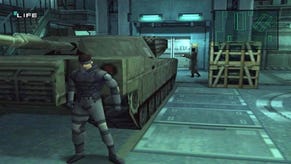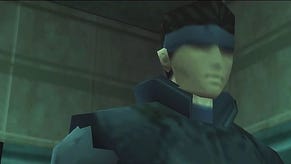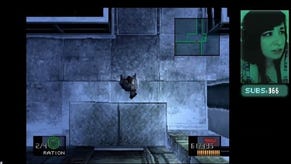Metal Gear Solid: The first modern video game
"You're very frank for a trained killer."
On September 3, 1998, Metal Gear Solid was released for the Sony Playstation, and games changed forever. Though an early 3D title, MGS was not the first third-person game influenced by cinema, nor was it Hideo Kojima's first time as director, and it wasn't even the first game in the series. It was a direct sequel to Metal Gear and Metal Gear 2: Solid Snake, 8-bit top-down games which had pioneered stealth mechanics, but also a fresh start - the moment when technology could realise these ideas anew.
1998 was a great year for games - kicking off with Resident Evil 2 and ending with Half-Life - but even among such company Metal Gear Solid stands apart. Kojima's techniques have contradiction at their core: an action game about avoiding action, for example, or fusing cinematic techniques to an interactive medium.
Press start and Metal Gear Solid begins with an FPS view from underwater, looking across the opening dock area. After codec introductions the first screen to use the game's standard camera angle shows a 'hidden' ration in the water below - but when Snake goes in to retrieve it the angle switches from top-down to side-on, 'hiding' the item behind some barrels. You know the ration's there, so run Snake in anyway and get the reward. Minor as it is, this is Kojima's first 3D trick.
The word 'Solid' in the title is a pun, referencing not just protagonist Solid Snake but also the switch from top-down 2D to the more 'solid' world of 3D. Kojima approached 3D design in a literal fashion - he built the levels using Lego bricks. Nor was this just a matter of modelling: the team hooked up a camera that could be positioned over their constructions and fed to a PC, giving Kojima and his team a 'real life' guide to creating perspective and proportion (the process can be seen in this Japanese making-of video).

The top-down camera angle that Metal Gear Solid favours is above Snake's shoulders and slightly angled - but the genius is that it switches both dynamically and to fixed positions. When Snake is moving through an area certain locations will trigger a change to a new fixed camera angle, which can be anything from side-on and distant to up-close and claustrophobic. This allows Kojima to 'direct' how a given location will look at different times as a player moves through it. But atop this the player can go into a stationary first-person view, or push Snake against a wall to trigger a more shoulder-level perspective.
Even now this is an unusual mix of techniques, the curated view alongside player freedom, and one of the reasons MGS has such high production values. It is a game built to withstand examination, which incidentally is why Kojima's habit of rewarding curiosity fits so well.
The standard perspective is also something of a compromise, however, because the level of detail MGS wants to hit in its environments means that there can't be too much on-screen. This in turn affects MGS's stealth system, which is a transition stage between the arcadey feel of the 8-bit originals and the much more detailed stealth simulation of MGS2 onwards.
Guards have tiny vision cones, shown on the 'Soliton' radar, and patrol fixed routes in predictable ways. There are a few great touches such as how they hear steps in water and can see footprints in snow - though both techniques are infrequently used. The rudimentary AI is also disguised by great additions like radio chatter, bespoke animations for going to the bathroom and so on. When they spot Snake an alert is triggered where all guards home in on Snake like typical shooter baddies and can kill him quickly, though once you're out of sight their attention soon slips, giving the inevitable panics an exciting cat-and-mouse feel.
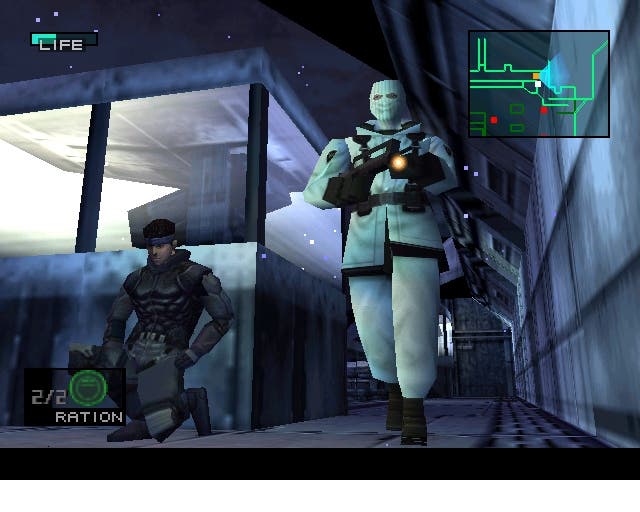
Creating such a strong core would be enough for most developers, but for Kojima and his team this was just the start. MGS is designed to be an epic, a game that looks at the world through the prism of alternate history, blending real events and characters into its fictional geopolitics. The script, the in-engine cutscenes, and the codec are part of an all-encompassing structure designed to deliver the narrative arc an action game requires while giving free reign to Kojima's plentiful hobbyhorse topics.
The script has the odd dud line but is also capable of jarring moments: after Snake flirts with Mei Ling, she replies "you're very frank for a trained killer." So too is the vocabulary carefully-calibrated, from Snake and Campbell's chats full of silly merc jargon ("they're armed with five-five-sixers and pineapples"), to Snake's drill instructor attitude towards Meryl ("This isn't a game, our lives are riding on this!") and various leaps into technological ethics and realpolitik from scientists Naomi and Otacon.
Kojima is able to get away with such a digressive script because lots of it is optional and MGS's through-line is beautifully-plotted. Snake's mission is to rescue two hostages from a military base commandeered by terrorists, and investigate whether the group is capable of launching a nuclear attack. Simple enough.
Soon after entering the facility you overhear guards talking about another intruder who's killed six guards. You find one hostage, who reveals the existence of a new Metal Gear then dies in front of you. Then you find the second hostage - who also dies. Snake starts to wonder if he's carrying something, or if his superiors are hiding things. And so on through a carnival line-up of Fox Hound, torture chambers, triple-crosses and prison escapes, until Snake's fist-fighting his brother atop a burning Metal Gear and zooming off in a jeep.
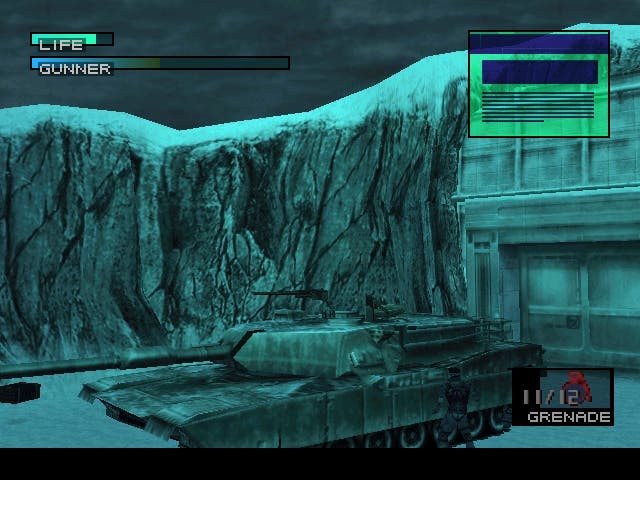
MGS makes a linear story feel dynamic through this simple tactic of regularly upsetting the player's expectations. It even enhances the effect by allowing you to 'meet' characters like Gray Fox on the codec at different places, depending on how you're playing, while completely missing other side characters.
The codec is Kojima's direct line to the player. Present in the earlier games but born anew thanks to the Playstation's chosen storage format of CD, every line is recorded by a team of voice actors that, at this point in the industry's evolution, were on a different level to what had come before. But the codec is far more. In Kojima's hands it becomes an essential tool for exploring such a complex 3D world, as well as a source of endless trivia loosely inspired by Snake's current situation.
One fantastic use is when it threads together the mechanics and theme of a nuclear storage area. Snake's team has been discussing the irresponsible disposal (or lack of it) of 'old' nuclear material worldwide. This leads up to the 'Nuke Bldng' location, a large room furnished with decommissioned nuclear warheads, where Snake is forbidden to use weapons.
Understandably miffed, Snake vents about the craziness of decommissioned nukes just being "piled up" by the U.S. Government, and then the player has to go through a stealth section stripped of their offensive ordnance. As you creep around these giant stacks of old warheads your mild annoyance, too, comes to rest on the irresponsibility of their existence. It's a trick, of course, and a great one - allowing Kojima to change things up by briefly restricting your options. But MGS's ending returns to the point with a splash screen stating how many tens of thousands of decommissioned warheads remain in the world.
MGS carries a clear anti-nuke message, but the core theme is genetics. The Selfish Gene theory, a theory of evolution that explains familial bonds, is the main driving force for Liquid Snake. This RSC reject is Solid Snake's clone 'brother,' the game's main antagonist, and essentially believes that a person's genetic code dictates their life and fate. While this is certainly grandiose, and Liquid's voice actor chews through several tonnes of scenery, it's really the jumping-off point for other characters to pontificate on the topic in more nuanced ways.
Naomi wants to find out who her parents were through genetics, while Otacon feels he's failed to escape his genes: despite stiff competition, the game's most forced revelation is that the Metal Gear designer's grandfather worked on the Manhattan Project. Nevertheless these perspectives and more allow Kojima to weave together nukes and genes, the idea of good people creating something evil, and the powerlessness of individuals within the war machine.
MGS's take on The Selfish Gene theory is that it is a scientific explanation for natural behaviour - but that humans' ability to choose their fate, to use reason, means it is not a prison. Which may not be earth-shatteringly profound stuff, but it's a nuanced theme for a game about nuclear mechs. And next to contemporaries like Resident Evil 2 or Tomb Raider III, it's positively Kubrick.

All of this makes Metal Gear Solid a tremendous game. What elevates it even further is the daring and ego of a creator that wanted to leave a personal mark. Kojima wasn't the first developer to put his name in a game (Warren Robinett, developer of 1979's Adventure was), and other pioneers like Richard Garriot had even inserted themselves as NPCs. But before Kojima no developer had ever woven their personality through a game's fabric in such an explicit way: both the world's god and its ever-present trickster.
This is not just a matter of Metal Gear Solid being, from the first, "A Hideo Kojima game." It's the obsessive chatter about movies, military history, and any other minutiae that comes to mind. It's the references to previous work found everywhere, from repeating MSX Metal Gear scenarios to Otacon's Policenauts poster. More than anything else, it was when Psycho Mantis faked out your TV to the VIDEO channel and it said HIDEO instead.
Mantis is the emblematic moment of MGS - a boss among bosses. Kojima has an unerring talent for creating memorable boss fights both inventive and various. In MGS Ocelot is faced in a hide-and-seek duel where the room's centre is rigged to blow. Sniper Wolf means a sniper battle down a long corridor with exaggerated camera sway (which you can dampen by taking pills), and then a second in a more troublesome environment. The battle against Liquid's Hind depends on quick first-person switches to lock-on missiles, while cuing the chopper's movements with surround sound. And then Vulcan Raven is the ultimate stealth challenge, a foe that cannot be faced head-on, in a large arena that allows for multiple strategies.
While these encounters are brilliantly-designed and staged, Mantis is elevated by a perfect match of theme (psychokinetic powers) and many fourth-walling gimmicks. Mantis analyses your playstyle thus far ("you are reckless"), 'reads' the PS1 memory card before commenting on any Konami saves, and then demonstrates the power of his mind by 'moving' your pad. This is all a great show, but as soon as the fight starts Kojima ups the ante by faking out the player - the screen goes blank except for the legend 'HIDEO,' the style mimicking older televisions' VIDEO channels, with a droning beep. Is this part of the game? The name shrinks. Seconds pass before the fight suddenly re-appears, with Mantis' maniacal laugh echoing through the speakers. Even here the tricks aren't done: Mantis cannot be hit ("I can read your mind") until the player physically switches their pad over to controller port 2.
Each is a great trick: the cascade of them makes it an unforgettable experience. Even now, once all the tricks are gone, it's a great fight built around the environment and Mantis's telekinetic abilities - he chucks vases around, makes books fly off shelves, sends busts arcing towards Snake, and floats around it all like a puppeteer. Beating Mantis feels like a mental and physical achievement - which is why he gets the HIDEO treatment. It's a signature.
One that marked Kojima's own ascent from game designer to games industry megastar. The great secret of MGS is that it was rushed, something which Kojima has been bitter about in the past - Konami set the date and it had to be released. This is most obviously seen in the game's vacuous closing task, which has Snake running back and forth across the same areas in an effort to pad out the playtime. The success of MGS put Kojima on a level where he could have walked out of Konami to any other developer - so he became nearly all-powerful within the company, was given enormous budgets for future MGS games, and would never again have to compromise.
Metal Gear Solid says he deserved it, because seventeen years later it holds up amazingly well. This is the most ambitious and sophisticated game of the early 3D era, a unique blend of systems design and narrative panache. Not a small part of this is that MGS respects its players' creativity and, exposition aside, never forgets how important that word 'play' is. The first modern video game? Perhaps that's a little strong. But the first stone-cold 3D classic that wasn't aimed at children or adolescents just isn't so snappy.
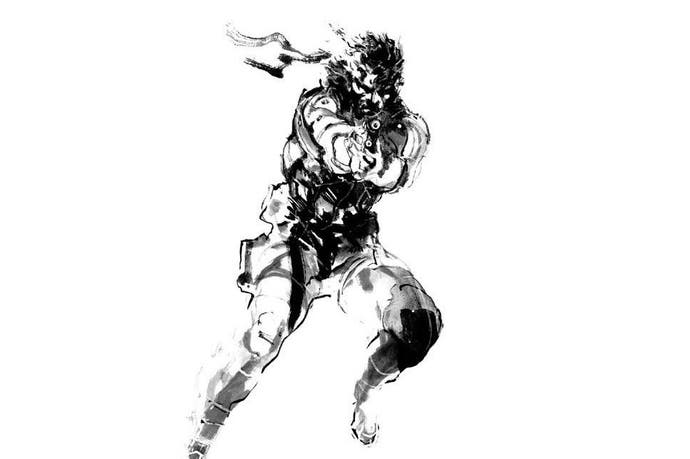



.png?width=291&height=164&fit=crop&quality=80&format=jpg&auto=webp)
